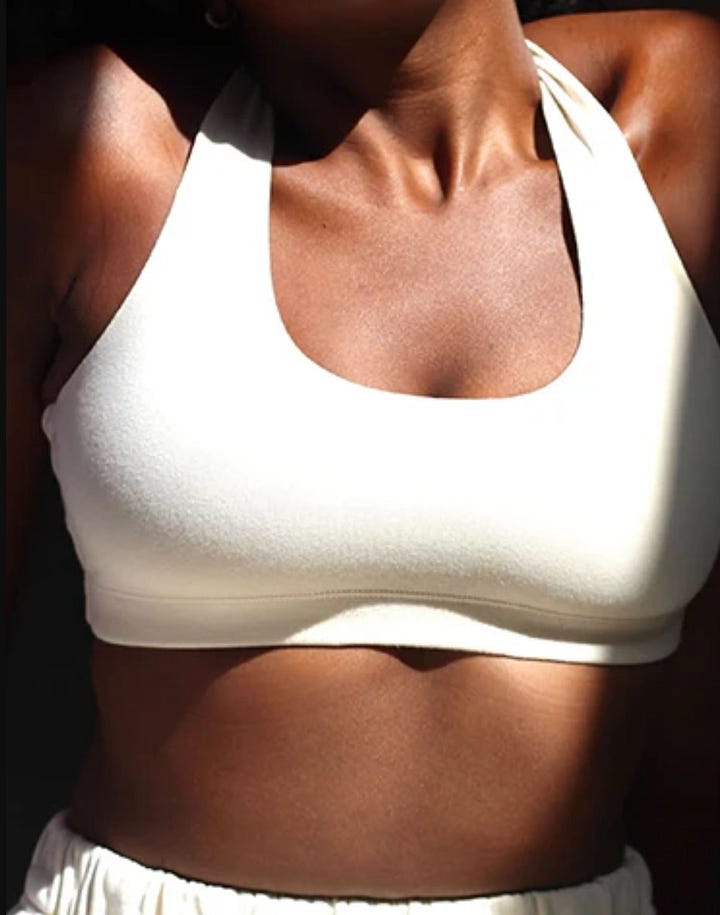Do clothes make us sick? | Why I’m double checking tags before check out
Synthetic vs. natural fibers and how much it matters in our home (and closet)
I’m tired. It never ends! One second you’re a carefree kid eating cheerios, and then you leave home and find out every grocery aisle you’ve ever loved is filled with ingredients banned in the EU.
So you cut out cereals and bagel bites to shop organic. You even buy glass tupperware and avoid chemicals from non-stick pans. Life seems good! The acne cleared up and you’re hitting the gym in your lulus. Flex.
Oh, but wait… Check the tag. Is that 98% polyester? Rayon?
Turns out, if you’re one to avoid wrapping warm food in plastic, then you might be shocked (and appalled, like me) when you hear wearing synthetic fibered lulu leggings is an analogy to burrito wrapping yourself in plastic and rotating in the microwave (via that sweaty gym sesh) on high. Skin is our biggest organ, so when your pores open, especially during a workout, you take in toxins making direct contact with your skin. Side note: this includes laundry detergents and fragrances that also aren’t natural. I know, I know, scary. Bear with me though.
So what exactly is the issue? We want facts
Endocrine-disrupting chemicals (EDCs) are natural or man-made chemicals that may mimic, block, or interfere with the body’s natural hormones. They can be found in many items we regularly come into contact with such as cosmetics, food packaging, household items such as carpets, and - that’s right - even clothing.
Why is this troubling? Studies are raising concern for the ability of chemicals to run off of fabrics and into the body after prolonged exposure with the skin.
Aka skin = sponge.


Health Risks
BPA (a key ingredient for manufacturing plastic) can be found in your polyester and nylon fabrics. Manufacturers think synthetic fabrics are a no brainer because they have higher profit margins, hold their dye better, as well as offer moisture-wicking properties. Unfortunately, they’ve now been linked to a variety of health risks from impacting fetal development to causing negative fertility effects in both men and women, affecting the onset of puberty in women and decreasing testosterone levels and causing erectile dysfunction in men.
Further research focused on the impact BPA has on our metabolism, linking exposure to obesity and insulin-resistance.
BPA has also been linked to a higher chance of breast and prostate cancer.
The list goes on!
Don’t even get me started on the poly and perfluoro-alkyl substances (PFAS, also known as “forever chemicals”), phthalates (used for softening effects), pesticides (also found in your natural but non organic fibers), formaldehyde (used for wrinkle resistance + fixing dyes to fabric), or flame retardants.
Not to mention the environmental consequences.
It’s everywhere
And insidious! Something you don’t immediately recognize as harmful - just like the cereal aisles of our youth.
These toxins are not only found in your closet, but your living room too. As an interior designer, I encourage clients to invest in natural fibers like mohair or linen when upholstering furniture, or that they invest in wool rugs. Not only do they have a tangible difference in feel and comfort, but they’re usually more durable than you think (minus velvet, ha!) and don’t emit V.O.C.s (Volatile Organic Compounds).
Plastic fibers surround us everyday in the form of clothing, upholstery, window coverings, bedding and more. These airborne chemicals can cause skin irritation, respiratory distress, and even contribute to the development of allergies and asthma.
I realize it’s a microplastic world we live in, but details matter. And if I’m getting anything right in this life, it’ll be our home and health.
However… looking in my closet, I can’t afford to replace every polyester piece with one made of cotton or linen… I’m clinging to my single cashmere sweater for dear life. And home wise, sofas ain’t cheap.
Baby steps to a better home (and closet)
Swap out plastic-based fabrics (think: polyester, nylon, acrylic, and lycra) for certified organic, naturally occurring products (such as, organic cotton or tencel). The lower percentage of synthetics and the higher the percentage of natural fibers, the better.
Where to start:
Cotton underwear. This is a budget friendly fast fix and arguably the most important one (being so close to home). There’s also Amazon for affordability and Araks if you’re feeling fancy.
Bedding. We spend 6-8 hrs every night lying belly down and face first into our pillows, so I replaced everything with 100% organic cotton sheets and down feather pillows.
Gym clothes. I focused on the cotton undies first, a pair of cotton leggings (not baggy like you’d think!), and cotton sports bras.
PJs. I’ll accept any excuse for new pjs. Piglet usually has a great Black Friday sale if you wanna hold out till then.
Throw blankets. I bought this handmade vintage kantha quilt off Etsy, from India, and tucked it around our sofa cushions at home. I’ve also been loving this throw from Amazon that you’d never guess was Amazon.
Draperies. Turns out Ikea offers 100% cotton curtains. Bless.
I’d love to reupholster our sofa or replace the rugs, but it’s likely not in the budget until our next move and that’s okay. It’s not perfect, but we’ll make better decisions moving forward. And I’m learning that a good filter is to ask whether something was normal 100 to 1,000 years ago (or more thoroughly, 10,000 years ago) e.g. “what did they wash clothes with before Tide (and its mile long list of chemical ingredients) came around?”. If a popular product didn’t exist 1,000 years ago, then it probably doesn’t make evolutionary sense and has consequences we’ve yet to uncover. I need more than “it’s normal” nowadays.
Nylon didn’t even exist until 1935 when it was invented for hosiery and then parachutes and airplane tires in WWII.
…And don’t get me started on fabric frequencies 🤪🤣 That’s another Substack entirely.
Upon crawling out of these rabbit holes, I was exhausted. Now I have to filter the source and contents of both my food AND fabrics?? It’s the 21st century but it seems we’re still hunters and gatherers - the difference being that instead of lions, tigers, and bears being the danger, we have to watch out for companies and governments cutting corners or creating bad incentives or lack of transparency. Wolves dressed as sheep.
On a positive note, I’ve noticed life is simpler now. The elimination of choices turned into a freedom that allotted the greatest gift - time.
Never again will I sift through +$100 polyester dresses (a criminal ROIC). “Oh, it’s not organic cotton or linen? Immediate pass.” I can then go about my life and when a great piece comes along, snag it.
That’s another thing - there’s no rush! Don’t feel pressure to turn your home upside down and replace everything all at once. It was easier to refill our fridges, but home and closet items are a huge investment and going forward with this knowledge will compound into a healthier home environment over time, promise.
Double xoxo,
Wendie
P.S. Thank you for reading… feel free to smash that ❤️ button if you liked this post : )
P.P.S. I get that I derailed a little bit from my usual focus on fashion, interiors, or design-led travel… but I feet the makeup and materiality of our clothes and furniture are by definition design related. It’s all in the details. What do you think? And was this post total news to you or have you been knee deep in this topic for a while now? If the latter, any tips?









